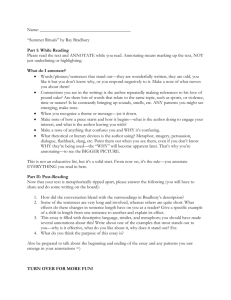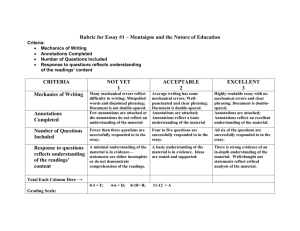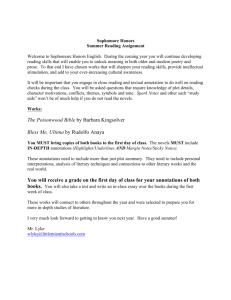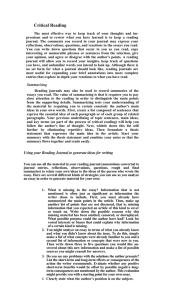Prince of Peace Christian School Summer Reading 2015
advertisement
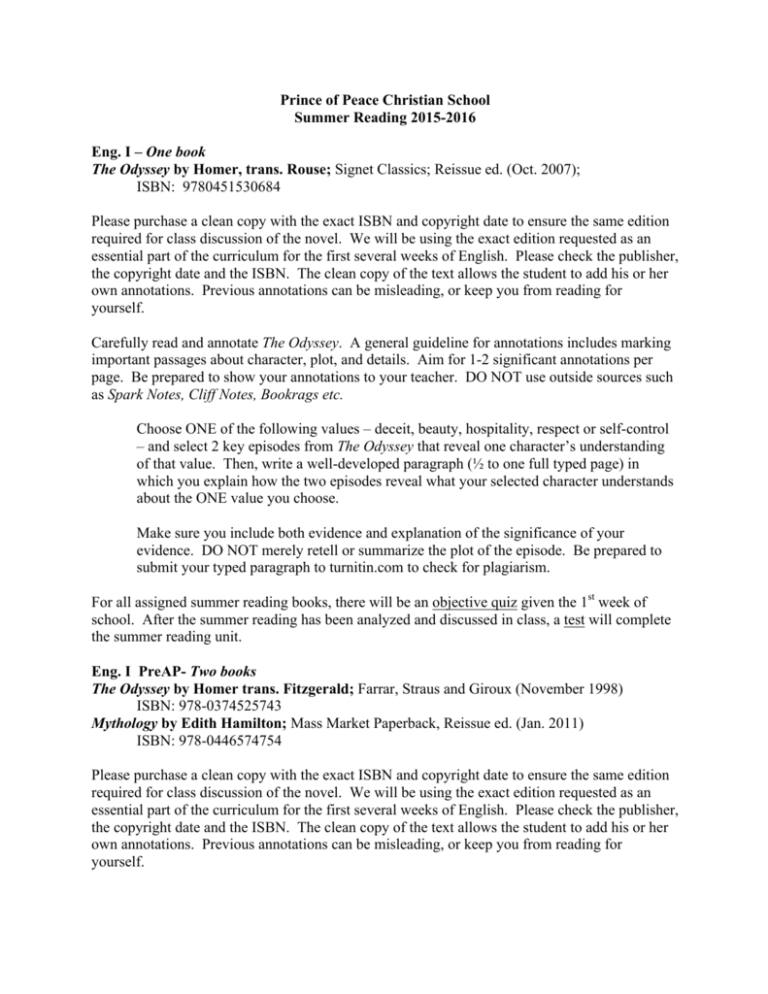
Prince of Peace Christian School Summer Reading 2015-2016 Eng. I – One book The Odyssey by Homer, trans. Rouse; Signet Classics; Reissue ed. (Oct. 2007); ISBN: 9780451530684 Please purchase a clean copy with the exact ISBN and copyright date to ensure the same edition required for class discussion of the novel. We will be using the exact edition requested as an essential part of the curriculum for the first several weeks of English. Please check the publisher, the copyright date and the ISBN. The clean copy of the text allows the student to add his or her own annotations. Previous annotations can be misleading, or keep you from reading for yourself. Carefully read and annotate The Odyssey. A general guideline for annotations includes marking important passages about character, plot, and details. Aim for 1-2 significant annotations per page. Be prepared to show your annotations to your teacher. DO NOT use outside sources such as Spark Notes, Cliff Notes, Bookrags etc. Choose ONE of the following values – deceit, beauty, hospitality, respect or self-control – and select 2 key episodes from The Odyssey that reveal one character’s understanding of that value. Then, write a well-developed paragraph (½ to one full typed page) in which you explain how the two episodes reveal what your selected character understands about the ONE value you choose. Make sure you include both evidence and explanation of the significance of your evidence. DO NOT merely retell or summarize the plot of the episode. Be prepared to submit your typed paragraph to turnitin.com to check for plagiarism. For all assigned summer reading books, there will be an objective quiz given the 1st week of school. After the summer reading has been analyzed and discussed in class, a test will complete the summer reading unit. Eng. I PreAP- Two books The Odyssey by Homer trans. Fitzgerald; Farrar, Straus and Giroux (November 1998) ISBN: 978-0374525743 Mythology by Edith Hamilton; Mass Market Paperback, Reissue ed. (Jan. 2011) ISBN: 978-0446574754 Please purchase a clean copy with the exact ISBN and copyright date to ensure the same edition required for class discussion of the novel. We will be using the exact edition requested as an essential part of the curriculum for the first several weeks of English. Please check the publisher, the copyright date and the ISBN. The clean copy of the text allows the student to add his or her own annotations. Previous annotations can be misleading, or keep you from reading for yourself. This summer, you will go on a voyage with the Greek hero Odysseus as he returns from the Trojan War to his beloved Ithaca, his faithful wife, and his loving son. Before you begin, you should read the background information on the Trojan War included in your copy of Edith Hamilton’s Mythology, “Part Four: Heroes of the Trojan War,” including the chapters on “The Trojan War,” ‘The Fall of Troy,” and “The Adventures of Odysseus”. As you read about each of Odysseus’ adventures, consider the trials he must face. Odysseus’ character is portrayed in his ability to handle dangerous situations. The trials illustrate more than just temptations that he must overcome; they show a different man at the end of the book than at the beginning. His adventures in his journey humble his pride, reveal his cleverness, and prepare him, by giving him self-control, for the task of restoring order to his household and to Ithaca. In each of the twelve adventures listed below, Odysseus is tempted to display a negative character trait or to choose a false identity that he must reject, and he is encouraged to demonstrate a positive trait. This is the basis of your summer essay. Choose three of the adventures to discuss in your essay, including a brief summary of each, the negative trait he must overcome or reject, and the positive trait that he embraces to succeed. 1. Begin with a brief thesis sentence that lists title and author, the three adventures, and the idea of Odysseus’ choices. This sentence may be the only sentence in your first paragraph. 2. In each of the following three paragraphs, you will summarize the adventure, discuss the negative trait, and explain the positive character trait that Odysseus demonstrates. 3. Include a concluding paragraph that pulls your ideas together. 4. The essay will be submitted to turnitin.com to check for plagiarism. Carefully read and annotate the following sections of Mythology by Edith Hamilton and then complete the assignment. 1. Carefully read and annotate Part One, Chapters I and II of Mythology. According to classical mythology, the universe began in chaos, which generated forces that led eventually to the creation of the Titans, two of whom were Cronus and Rhea. Determined not to let any of his children usurp his power, Cronus ate them as soon as they were born, but one of these, Zeus, fought his way out and freed his siblings. They became the first of the Olympian gods. The Greek gods are not perfect; in fact, they have all the flaws that characterize human beings, but much more power. Using your mythology book as a reference, type a description of the characters listed below. Include the Roman (Latin) name, symbols, and realm, if available. This typed description will be turned in the first day of school; be prepared to submit the description to turnitin.com to check for plagiarism. Be prepared for a quiz on these figures during the first week of school. Include a description for the following: Zeus, Poseidon, Hades, Hera, Hestia, Ares, Athena, Apollo, Aphrodite, Hermes, Artemis, Hephaestus, Demeter, Dionysus, Persephone, Cyclops, Calypso, and Circe. 2. Carefully read and annotate Part Four, Chapters I, II, and III of Mythology. These chapters will give you a summary and overview of the Trojan War described in The Iliad and The Odyssey and will be helpful as you read and write about The Odyssey. For all assigned summer reading books, there will be an objective quiz given the 1st week of school. After the summer reading has been analyzed and discussed in class, a test will complete the summer reading unit. English II – One book Lord of the Flies by Golding; Perigee Trade; Casebook ed. (Sept. 1987) ISBN: 9780399506437 Please purchase a clean copy with the exact ISBN and copyright date to ensure the same edition required for class discussion of the novel. We will be using the exact edition requested as an essential part of the curriculum for the first several weeks of English. Please check the publisher, the copyright date and the ISBN. The clean copy of the text allows the student to add his or her own annotations. Previous annotations can be misleading, or keep you from reading for yourself. Carefully read and annotate Lord of the Flies. A general guideline for annotations includes marking important passages about character, plot, and details. Aim for 1-2 significant annotations per page. Be prepared to show your annotations to your teacher. DO NOT use outside sources such as Spark Notes, Cliff Notes, Bookrags etc. Choose two of the following characters: Ralph, Jack, Piggy, Simon. Then choose a different scene for each character that gives the most insight into their character. Write one welldeveloped paragraph for each of your 2 characters: a total of 2 paragraphs. Each paragraph should be ½ to one full page. For example, if you selected Ralph, choose the one scene that reveals the most about Ralph, noting both the details of the scene and their significance. You will have 2 separate paragraphs (no “big” thesis tying it all together). Make sure you include both evidence and explanation of the significance of your evidence. DO NOT merely retell or summarize the plot of the episode. Be prepared to submit your typed essay to turnitin.com to check for plagiarism. For all assigned summer reading books, there will be an objective quiz given the 1st week of school. After the summer reading has been analyzed and discussed in class, a test will complete the summer reading unit. English II PreAP – Two books Of Mice and Men by Steinbeck ; Penguin (January 8, 2002) ISBN: 9780142000670 Frankenstein by Mary Shelley; Bedford/St. Martin's; 2nd ed., Case Studies ed. (April 14, 2000) ISBN: 9780312191269 Please purchase a clean copy with the exact ISBN and copyright date to ensure the same edition required for class discussion of the novel. We will be using the exact edition requested as an essential part of the curriculum for the first several weeks of English. Please check the publisher, the copyright date and the ISBN. The clean copy of the text allows the student to add his or her own annotations. Previous annotations can be misleading, or keep you from reading for yourself. Carefully read and annotate your two books. A general guideline for annotations includes marking important passages about character, plot, and details. Aim for 1-2 significant annotations per page. Be prepared to show your annotations to your teacher. DO NOT use outside sources such as Spark Notes, Cliff Notes, Bookrags etc. Both of these works confront the reader with scenes of violence. Choose a key scene of violence from both works: total of 2 specific scenes (spanning 1-3 pages each), one from each work. In a well-organized essay, compare and contrast how these two scenes contribute to the meaning of the entire work. Aim for a critical mass of 2 1/2-3 pages (Times New Roman 12, 1 inch margins, all doublespaced). Make sure you include both evidence and explanation of the significance of your evidence. DO NOT merely retell or summarize the plot of the episode. Be prepared to submit your typed essay to turnitin.com to check for plagiarism. For all assigned summer reading books, there will be an objective quiz given the 1st week of school. After the summer reading has been analyzed and discussed in class, a test will complete the summer reading unit. English III – One book Scarlet Letter by Hawthorne; Dover Thrift (1994) ISBN: 978-0486280486 Please purchase a clean copy with the exact ISBN and copyright date to ensure the same edition required for class discussion of the novel. We will be using the exact edition requested as an essential part of the curriculum for the first several weeks of English. Please check the publisher, the copyright date and the ISBN. The clean copy of the text allows the student to add his or her own annotations. Previous annotations can be misleading, or keep you from reading for yourself. Carefully read and annotate The Scarlet Letter. Be prepared to show your annotations to your teacher. DO NOT use outside sources such as Spark Notes, Cliff Notes, Bookrags etc. The following is a list of symbols in the novel that will be the basis of your summer essay. Choose the top 3 symbols you would like to explore and email your choices to Mrs. Ashcraft at ashley.ashcraft@popcs.org. Since only two people can choose each symbol, the sooner you choose, the more likely you will receive your first choice. Mrs. Ashcraft will reply with your assigned symbol. 1. Doors/Thresholds 2. Weeds/Vegetation/Flowers 3. Forest/Town 4. 3 scaffolds 5. Color black 6. Color green 7. Color gold 8. Color red 9. Triads (groups of three) 10. Mirrors/Reflections 11. Sunlight/Darkness 12. Draperies and Curtains 13. Pearl 14. Steps 15. Water Your essay should explore the symbols as follows: 1. Introduction including a thesis that draws a conclusion about Hawthorne’s purpose in using the symbol and the theme represented by it. 2. Body paragraph about 2-3 appearances of the novel, using quotes and MLA documentation 3. Body paragraph about the meaning of the symbol. How does the symbol convey the theme and purpose of the novel and what effect does it have on the reader? 4. A concluding paragraph that answers the “so-what” question: how is the meaning of the symbol “like life” or how is the meaning of the symbol universal? The essay will be due during the first week of classes and will be submitted to turnitin.com to check for plagiarism. For all assigned summer reading books, there will be an objective quiz given the 1st week of school. After the summer reading has been analyzed and discussed in class, a test will complete the summer reading unit. AP Language– Two books Scarlet Letter by Hawthorne; Dover Publications (May 2, 1994) ISBN: 9780486280486 Language of Composition by Shea, Scanlon, and Aufses; 2nd ed. ISBN 9780312676506 Please purchase a clean copy with the exact ISBN and copyright date to ensure the same edition required for class discussion of the novel. We will be using the exact edition requested as an essential part of the curriculum for the first several weeks of English. Please check the publisher, the copyright date and the ISBN. The clean copy of the text allows the student to add his or her own annotations. Previous annotations can be misleading, or keep you from reading for yourself. 1. Assignment for The Scarlet Letter: Respond to the following prompt in a well-developed essay of no longer than 750 words (include a word count at the end of the essay). The essay must be in 12 font, Times New Roman, double-spaced with MLA formatting. Nathaniel Hawthorne wrote The Scarlet Letter in 1850, during the age of Romanticism and Transcendentalism. Hawthorne was a friend and neighbor of such transcendental writers as Ralph Waldo Emerson and Henry David Thoreau, who viewed man as naturally good and who believed in the possibility of creating a utopian society. On the other hand, Hawthorne was a product of his Puritan ancestors who believed that man is naturally depraved and sinful; one of Hawthorne’s ancestors was Judge John Hathorne who was a judge in the notorious Salem witch trials that took place in New England in 1692. Hawthorne chose Boston in 1642-49 as the setting for his novel. Write a wellorganized essay which addresses the possibility that a piece of fiction can be an argument. Consider The Scarlet Letter as Hawthorne’s anti-utopian argument in response to his transcendentalist contemporaries or his moral argument in response to his Puritan ancestors. 2. Assignment #2 Activity and quiz on Chapter 1 of The Language of Composition: Carefully read and annotate chapter one of your text book, The Language of Composition. Complete the Activity on page 6. Type a SOAPS analysis of the “9/11 Speech” by George W. Bush. This analysis will be turned in on the first day of class. Also, be prepared for a quiz on the “Glossary of Rhetorical Terms,” pages 36-38 to be given the first day of class. For all assigned summer reading books, there will be an objective quiz given the 1st week of school. After the summer reading has been analyzed and discussed in class, a test will complete the summer reading unit. English IV - One book King Lear by Shakespeare; Signet Classics; Revised ed (1998) ISBN: 9780451526939 Please purchase a clean copy with the exact ISBN and copyright date to ensure the same edition required for class discussion of the novel. We will be using the exact edition requested as an essential part of the curriculum for the first several weeks of English. Please check the publisher, the copyright date and the ISBN. The clean copy of the text allows the student to add his or her own annotations. Previous annotations can be misleading, or keep you from reading for yourself. Carefully read and annotate King Lear. Aim for 1-2 significant annotations per page. Be prepared to show your annotations to your teacher for a daily grade on the first day back in the fall. DO NOT use outside sources such as Spark Notes, Cliff Notes, Bookrags etc. DO USE the overview, the footnotes on each page, and a good dictionary. Think carefully and critically about each line and section before moving to the next. While reading King Lear, identify and collect examples of “madness” using page markers or a notebook. For each of the five acts, write a one-page journal entry (5 pages total) that includes the passage(s) you find that exemplify madness in some way followed by an explanation in your own words about how or why you believe this action, word or character could qualify as an example of madness (delusions, illusions, extreme actions or reactions, nonsensical rantings, etc.). Provide the act, scene and line for each quote. Please use MLA format, double-spaced, Times New Roman, 12 pt. font. For all assigned summer reading books, there will be an objective quiz given the 1st week of school. After the summer reading has been analyzed and discussed in class, students will recite select passages. Finally, a test on King Lear will complete the summer reading unit. AP Literature - Two books King Lear by Shakespeare; Folger, Simon & Schuster (2004) ISBN: 9780743482769 Heart of Darkness by Conrad; Norton critical ed.; 4th ed (Dec. 2005) ISBN: 9780393926361 Please purchase a clean copy with the exact ISBN and copyright date to ensure the same edition required for class discussion of the novel. We will be using the exact edition requested as an essential part of the curriculum for the first several weeks of English. Please check the publisher, the copyright date and the ISBN. The clean copy of the text allows the student to add his or her own annotations. Previous annotations can be misleading, or keep you from reading for yourself. 1. Assignment for King Lear: Respond to the following prompt in a well-developed essay no longer than 750 words (include a word count at the end of the essay): In many plays a character has a misconception of himself or his world. Destroying or perpetuating this illusion contributes to a central theme of the play. From King Lear, choose a major character to whom this statement applies, and write an essay in which you consider the following: A. What the character’s illusion is and how it differs from reality as presented in the play. B. How the destruction or perpetuation of the illusion develops a theme of the play. Do not merely summarize the plot. 2. Assignment for Heart of Darkness: Respond to the following prompt in a welldeveloped essay no longer than 750 words (include a word count at the end of the essay): Works of literature often depict acts of betrayal. Friends and even family may betray a protagonist; main characters may likewise be guilty of treachery or may betray their own values. From Heart of Darkness, consider such an act of betrayal. Then, in a well-written essay, analyze the nature of the betrayal and show how it contributes to the meaning of the work as a whole. Do not merely summarize the plot. For both essays, make sure you include both evidence and explanation of the significance of your evidence. DO NOT merely retell or summarize the plot. Be prepared to submit your typed essay to turnitin.com to check for plagiarism. The essay must be in 12 font, Times New Roman, double-spaced with MLA formatting. For all assigned summer reading books, there will be an objective quiz given the 1st week of school. After the summer reading has been analyzed and discussed in class, a test will complete the summer reading unit.
